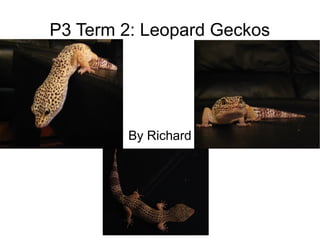
Richard p3 term 2 leopard geckos
- 1. P3 Term 2: Leopard Geckos By Richard
- 2. Introduction ● I am doing my p3 on geckos because I have one as a pet and it really surprises me in many different ways. The fact that surprised me the most was that the average lifespan of a Leopard Gecko is 15-35 years if well cared for. They can also survive without food or water for a remarkably long time without dying. They can go without food for more than two weeks and survive without water for just less than a week. They can endure lack of food for a very long time which surprised me. They are cold blooded and nocturnal.
- 3. Diet ● If living in the wild, Leopard Geckos eat insects, spiders and worms. Geckos refuse to eat anything dead and if they are a pet the best food to give them would be crickets. They have a good sense of smell and sight and stalk their prey like a real leopard. They walk around following insects and then their tails shake really fast and then they lunge at the crickets so quickly you can barely see the movement.
- 4. Size ● Leopard Geckos are much smaller than Bearded Dragons and other reptiles. Babies are usually 6-8 cm long and weigh about 3 grams. Adults are between 20 and 27 cm long and weigh 45-60 grams.
- 5. Shedding ● Geckos shed their skin once a month. A few days before shedding, their skin will turn a whitish grey colour. They do this by using their mouth to tear it off and don't leave any evidence behind as they eat the skin as soon as it comes off. Once the gecko has shed, the skin will be brighter. Reptiles shed their skin to allow growth and to remove parasites on their old skin.
- 6. Habitat ● Leopard Geckos generally live in the deserts of India, Afghanistan and southern Pakistan. They do not like the light and are nocturnal so during the day they are usually in dark places:under rocks and caves.
- 7. Defensive traits ● Leopard geckos' predators are snakes, frogs, and foxes. Their good sense of hearing and sight help them escape from them at night. Their skin also helps as it camouflages well from the predators. Shedding their skin also gets rid of any scent the predators are following. When they feel threatened they hiss to ward off predators. As well as avoiding heat, geckos hide in holes and burrows to hide from predators. Geckos also have the amazing ability to detach their tails voluntarily if grabbed by the tail or attacked by predators. This ability is called caudal autotomy. The tail also has some weight so the gecko can travel faster without one. Detaching doesn't harm the gecko, but if it doesn't grow back the gecko can get sick and possibly die.
- 8. Observations ● If I put my gecko down on the ground it will instantly try to escape. It sprints to the nearest dark spot underneath cabinets and shelves. If I put it down on the table it doesn't move for quite a while, and then tries to find a way off the table without falling. Whenever it is in its glass cage it is usually in one of the two rocks or is just under the heat lamp. It occasionally randomly walks around the area but not that often. As soon as it sees the crickets in the bag we are about to toss in her cage, her pupils get big and she crawls onto the highest point inside her cage and tries to get out to get the crickets. As soon as we dump them in, she looks for the nearest one. She can only see in front of her so it is hard for her to find a silent unmoving cricket. If the cricket is unmoving she starts forward very slowly. Once she gets close enough she stops, her tail starts moving really fast and then she moves her head and lunges at the crickets easily eating a dozen within a few minutes.
- 9. Characteristics ● Leopard Geckos in the wild have duller skin than those kept in captivity. The skin is also very durable and it can sustain the rocky and sandy terrain it lives on. They have small legs which allow them to be quick and agile. Instead of ears they have openings on either side of their heads. During the day they absorb heat and light so that they can have energy to hunt during the night.
- 10. Facts ● Most reptiles don't have eyelids, but Leopard Geckos do. ● Leopard Gecko genders are determined by temperature. At 90*F all unhatched geckos will be male and at 80*F all geckos will be female. ● If a Leopard Gecko is bitten and the skin grows back the skin will always be a different colour than the rest of it. ● Leopard Geckos are immune to scorpion stings. ● Most geckos have pads to help them climb but Leopard Geckos have small claws. ● Leopard Geckos' tails are used as a food storage in case if there is a lack of food.
- 11. Conclusion ● Even without all these facts I still find Leopard Geckos the most interesting of all animals. Who knew that such small things were capable of so much? The reason I chose this topic was because I have a pet Leopard Gecko, I already knew some information about it and that it was actually fun to write at times.
- 12. Bibliography ● en.wikipedia.org/wiki/leopard_gecko/ ● en.wikipedia.org/wiki/file:gecko999.jpg ● Melanie Anne Marie= www.flickr.com/photos/melanie@AnneMarie/263815 ● http://www.theultimateleopardgeckomanual.com/fun ● http://www.seaworld.org/animal-info/animal- bytes/animalia/eumetazoa/coelomates/deuteros tomes/chordata/craniata/reptilia/squamata/leop ard-gecko.htm